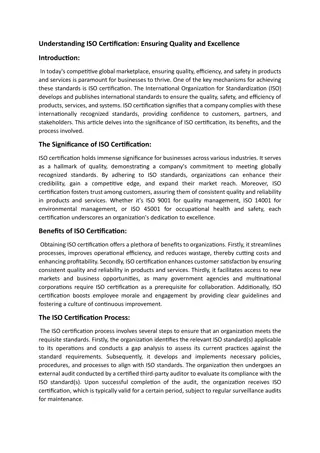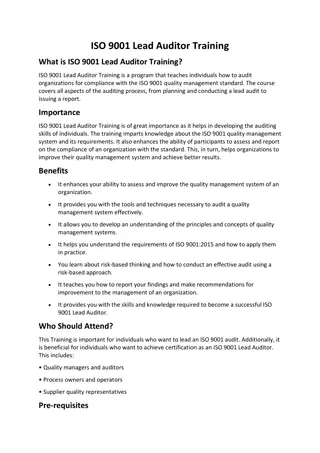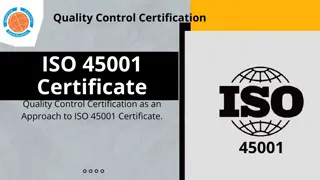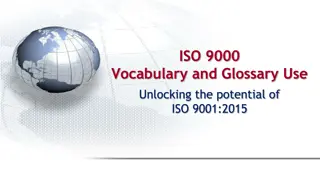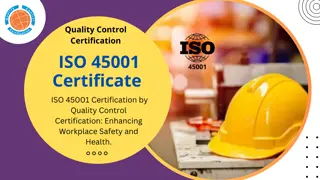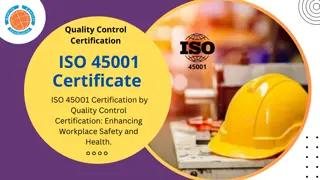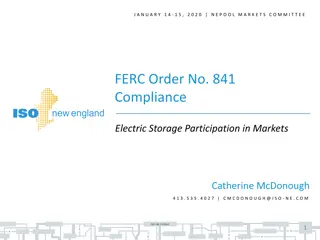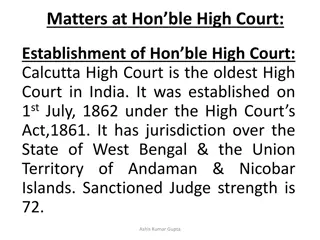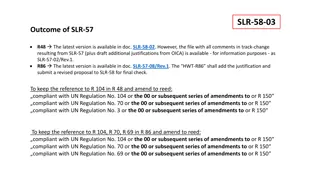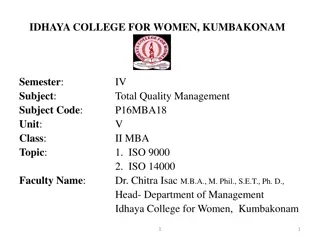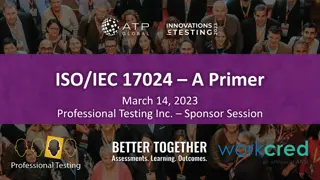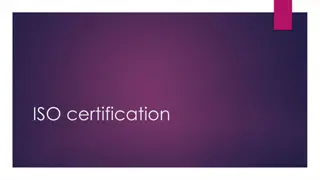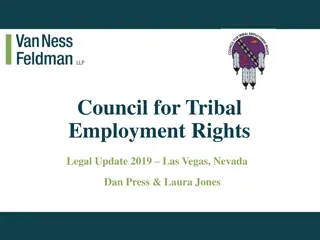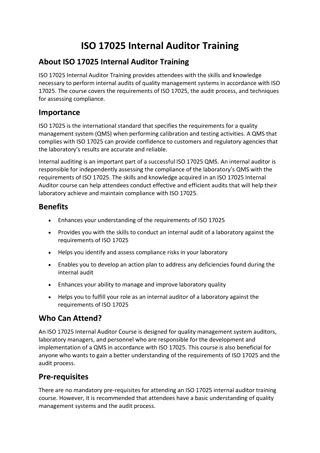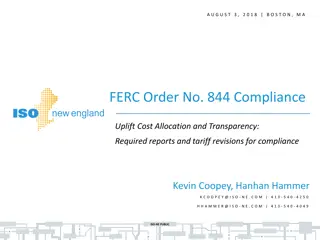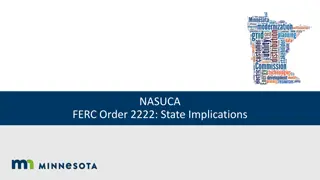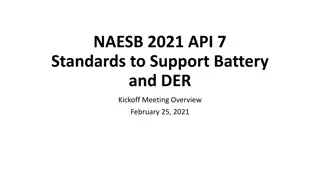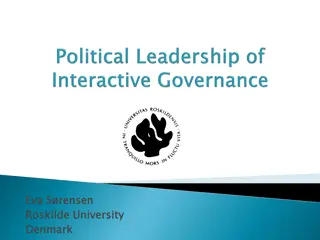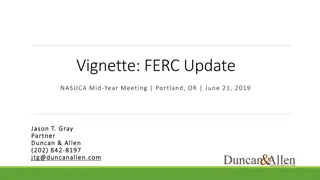Report on ISO/RTO Governance & Practices in FERC Jurisdiction
A recent report on the governance and practices of six ISOs/RTOs under FERC jurisdiction - CAISO, ISO-NE, NYISO, MISO, PJM, and SPP - compares stakeholder structures, Section 205 filing rights, board structures, and roles of state utility commissions. The report details stakeholder processes, board compositions, and director qualifications across the ISOs/RTOs, shedding light on key areas of comparison.
Download Presentation

Please find below an Image/Link to download the presentation.
The content on the website is provided AS IS for your information and personal use only. It may not be sold, licensed, or shared on other websites without obtaining consent from the author. Download presentation by click this link. If you encounter any issues during the download, it is possible that the publisher has removed the file from their server.
E N D
Presentation Transcript
Introduction A recent report comparing the governance and practices in the six ISOs/RTOs under the jurisdiction of FERC is available on the NESCOE website: California ISO (CAISO), ISO New England (ISO-NE), New York ISO (NYISO), Midcontinent Independent System Operator (MISO), PJM Interconnection (PJM) and Southwest Power Pool (SPP) Reports compares four key areas across the ISOs/RTOs: Stakeholder structure and processes; Section 205 filing right responsibilities under the Federal Power Act; Boards of directors structure and practices; and Associated roles and responsibilities of state utility commissions, state agencies, and regional state committees 1
Stakeholder Structure and Process AREA Open to Public? Yes Senior Committee None CAISO ISO-NE MISO NYISO PJM SPP No[1] Participants Committee Yes Advisory Committee Yes Management Committee Yes Members Committee Yes Markets & Operations Policy Committee SPP members NEPOOL members MISO members[2] PJM members[3] NYISO voting members NYISO non-voting members NY DPS/PSC NYISO members Voting Stakeholders None Non-Voting Participating Stakeholders NESCOE (and state commissions) Stakeholders Non-members Non-members Non-members NEPOOL members NESCOE 6 weighted sectors (66%/60%)[4] Yes (Participants Committee) Sponsor Stakeholders Stakeholders Stakeholders Stakeholders Issues/Proposals in the Stakeholder Process Senior Committee Voting Approach Appeals Process (to whom)? This matrix is focused on how stakeholders provide feedback on proposals and not necessarily the transmission planning process or other regional stakeholder processes that may be in place. 10 weighted sectors (66%)[5] No 5 weighted sectors (58%) Yes (Management Committee/Board) 5 weighted sectors (66%) No 2 weighted sectors (66%) Yes (Board) None Yes (Board) Note: 2
Board Composition AREA CAISO ISO-NE MISO NYISO PJM SPP Total # of Directors 5 Includes ISO/RTO CEO (ex officio)? Length of Term 3 years Qualifications (number of directors that must meet qualification) 10 Yes 10 Yes 10 Yes 10 Yes 10 Yes No 3 years Cross-section of industry skills including consumer advocacy/retail rate regulation (6) Electric industry (3) 3 years Corporate leadership (6) Electric operations (1) System planning (1) Markets (1) 4 years Corporate leadership or cross-section of industry skills (6) Electric industry (3) 3 years Corporate leadership or cross-section of industry skills (4) Operation of transmission utility (1) Electric operations & system planning (1) Markets (1) 3 years Corporate leadership or cross-section of industry skills (9) Corporate leadership and cross-section of industry skills (5) 3
Board Stakeholder Engagement AREA Other Board Attendance Meeting Requirements CAISO ISO-NE MISO NYISO PJM SPP Sector meeting State official meetings Board State Commission meetings Hot topic discussions Special quarterly Advisory Committee Membership meetings Each Advisory Committee (10) Ex parte sector meetings Liaison Committee General Sessions Liaison Subcommittee Annual membership meeting None Board Stakeholder Meeting Attendance (# of Board Members) Each Participants Committee (1) Each Management Committee, Business Issues Committee, Operating Committee (1) None None None 4
Director Selection AREA CAISO ISO-NE MISO NYISO PJM SPP 3 full consecutive terms None No Directors (3) Advisory Committee (2) Term Limit None 3 full terms 3 full terms 5 full terms None Age Limit None 70 Yes Directors (7) NEPOOL members (6) NECPUC (1) 1 75 Yes Board Management Committee 75 No Directors (3) PJM members (5)[6] None No SPP CEO Board Chair SPP members (9) In-Region Preference? No Nominating Committee Composition 6 sectors (36) Minimum number of candidates per position Initial Approval Entity Governor 4 2 3 1 1 Board[7] Participants Committee (6 weighted sectors of 70%) Board None None None MISO members[8] Members Committee 5 weighted sectors (50%) Individual Final Approval Entity State Senate Board SPP Members Final Approval Threshold 2 weighted sectors (66%)[9] Individual Majority Majority Majority Majority Group or Individual Vote Individual Group Individual Individual 5
Board Meetings, Communications and Decision Making AREA CAISO ISO-NE MISO NYISO PJM SPP Meetings Open Closed None Open Stakeholders Closed NY DPS/PSC FERC Closed None Open Members Committee Stakeholders Public Public Attendees (beyond Board and ISO/RTO Management) Stakeholders Agendas Public Minutes Public Public Board only (summary provided to Participants Committee) Board only No Public Public Stakeholders Public Board only Board only Meeting Materials Public Approves Regulatory Filings?[10] ISO/RTO CEO Vote? N/A Quorum 2/3rd of directors Public No Board only Yes Board only Yes Public Yes[11] Yes No Majority of elected directors Yes Majority of directors Yes 6 directors No Majority of elected directors Yes Majority of directors plus one additional director Majority Approval Threshold [12]Majority Majority Majority Majority Majority 6
Role of States in ISO/RTO Governance and Practices AREA CAISO ISO-NE MISO NYISO PJM SPP State Commission / State Committee Sponsor Issues/Proposals in Stakeholder Process? Role in Stakeholder CPUC and CEC NESCOE and NECPUC OMS PSC and NY DPS OPSI RSC Yes NESCOE only Yes Yes Yes Yes Non-voting Non-voting Voting Non-voting Non-voting Non-voting Process NECPUC: 1 seat on Nomination Committee State Regulatory Authorities or Public Consumer Advocates sector member[13] None Board Nomination Role None None None None State official meetings OPSI annual meeting Board Engagement None Liaison Subcommittee None Board liaison meeting with State Commission None NESCOE: Transmission Cost Allocation General Sessions Board Meeting Role Participant Form of Section 205 Filing Rights (where an entity files on their behalf) Participant Transmission Cost Allocation Participant None None None Participant Transmission Planning & Cost Allocation None NESCOE: Participants Committee Supported Proposal Resource Adequacy Note:Underlined items reflect differences from other participating stakeholders. 7
Endnotes [1] The ISO-NE transmission planning stakeholder process is open to the public. [2] Includes representatives from the State Regulatory Authorities, Public Consumer Advocates, and Environmental/Other Stakeholders sectors. [3] Affiliate members can only vote in technical committees. Associate members cannot vote. [4] 66.67% of the weighted sector vote for non-market rule changes and 60% of the weighted sector vote for market rule changes and the information policy. [5] Most proposals are not considered by the Advisory Committee and are only considered in the technical committees which generally use a straight-voting process by those parties assigned to a sector. [6] One member from each sector. [7]MISO Board selects a candidate from the nominating committee s recommended candidates. [8] Excludes non-paying members from the State Regulatory Authorities, Public Consumer Advocates and Environmental/Other Stakeholders sectors. [9] If there are multiple nominees, the weighted sector vote only needs to be 50%. 8
Endnotes (contd) [10] Refers generally if the board is reviewing proposed changes to the tariff. There is discretion for Boards to review or not review items depending upon a number of factors. [11] Items approved through the stakeholder process and that are not appealed specifically to the SPP Board are not reviewed and approved by the Board. [12] Approval threshold for general matters brought to the board. Most regions have different thresholds defined for the handling of certain specific matters. [13] Onlytwo members of the Advisory Committee are selected, so while this could include members from these sectors, it also may not. 9



